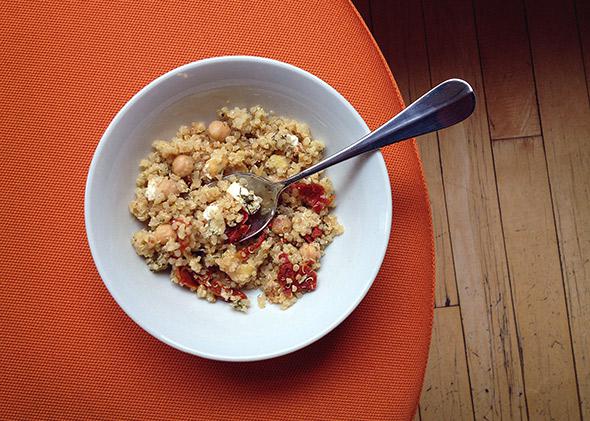Quinoa has been described as a “superfood,” “miracle grain,” “powerhouse seed.” I never really got what all the fuss was about, honestly. I mean, yeah, sure, it’s high in protein and gluten-free, but when you cook it, it resembles every other grain: fluffy, starchy, bland. It’s filler, something there to take up space between more interesting stuff. Quinoa is the edible equivalent of Tim Carleton’s “Opus No. 1,” one of the most popular pieces of telephone hold music.
Which is to say that the key to making quinoa taste good is to add good-tasting things to it. There’s only so much you can do to enhance quinoa’s natural flavor and texture: Use the right amount of water, don’t cook it too long, don’t forget the salt, etc. (Lots of people tell you to rinse it before you cook it to remove bitter compounds, but most quinoa is pre-rinsed, so it’s usually not necessary.) Sautéing the seeds in oil or butter before you add water is always a good idea—it leads to a fluffier end product by preventing the grains from sticking together—but the most important thing is what delicious things you add to flavor the quinoa.
Here is a blueprint for making a good quinoa pilaf (or any other kind of pilaf, for that matter). You do not need to add all of these types of ingredients every single time, but you should definitely add most of them if you want to protect yourself from the vexatious fate of tedious quinoa.
First you need an allium. Onion, scallion, shallot, leek, or garlic will do. Slice or chop it and cook it in oil or butter until it’s soft.
Then, add the quinoa, toast it in the oil for a few minutes, and throw in some nuts or beans along with some dried fruit. The dried fruit does not have to be a super-sugary dried fruit—in the below recipe, for instance, I use dried tomatoes—but a little sweetness to counterbalance savory flavors is always nice. Some fruit-nut combinations are obvious (raisin-walnut, cranberry-pecan, apricot-almond), but by all means mix things up.
After you’ve added water and cooked the grains thoroughly, turn off the heat and toss in some cheese and fresh herbs. For pilafs, I like a crumbly cheese, like feta, ricotta salata, or gorgonzola, which is less likely to get gluey than a grated cheese. As for herbs, anything goes—parsley, cilantro, basil, mint, dill, rosemary, thyme, oregano. Be careful not to overdo it with the more powerful herbs; rosemary, for instance, can easily overpower a dish.
These five categories of ingredient will guide you on your quest to make quinoa that kinda-sorta lives up to the moniker “superfood.”
Quinoa Pilaf With Chickpeas, Feta, and Sun-dried Tomatoes
Yield: 4 to 6 servings
Time: About 1 hour, partially unattended
2 tablespoons extra-virgin olive oil
1 leek, white and light green parts only, chopped
Salt and black pepper
1½ cups quinoa
½ cup roughly chopped sun-dried tomatoes
½ cup drained cooked chickpeas
4 ounces feta cheese, crumbled
2 tablespoons chopped fresh dill
1. Put the olive oil in a medium pot over medium-high heat. When it’s hot, add the leek and season with salt and pepper. Cook, stirring occasionally, until it softens, 8 to 10 minutes.
2. Add the quinoa and stir until it dries out and begins to stick together, about 5 minutes. Add the tomatoes, the chickpeas, and 3 cups of water. Raise the heat to high and bring to a boil, then cover the pot and adjust the heat so the mixture simmers gently. Cook until the quinoa has absorbed all the liquid and is tender, 15 to 20 minutes.
3. Remove the pot from the heat and let sit for 5 minutes. Stir in the feta and dill, then taste and adjust the seasoning. Serve hot, warm, or at room temperature. (Store leftover quinoa pilaf in an airtight container in the refrigerator for up to several days.)
Previously in You’re Doing It Wrong:
Nuts
Okra
Dumplings
Grapefruit
Tofu
Almond Milk
Hummus
